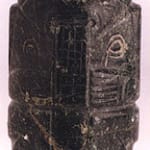Central Pacific Jade Tubular Pendant, 100 CE - 500 CE
Jade
5
PF.2673
In the context of Pre-Columbian art and archaeology, jade is a generic term that refers to any variety of hard, dense stones that were worked with great skill by native...
In the context of Pre-Columbian art and archaeology, jade is a generic term that refers to any variety of hard, dense stones that were worked with great skill by native artists. Although jade is generally thought to be green, it can actually be a range of colors. Jade carving flourished in ancient Costa Rica for over a thousand years, roughly from 500 B.C. to 900 A.D., although the period of greatest artistic accomplishment lasted from 300 to 700 A.D. It is believed that jade working began during an extended period of agricultural abundance that allowed the ancient society to dedicate part of its energies toward the cultivation of artistic pursuits.
Jade was considered to be a sacred material by the ancient populations of Costa Rica, held in even higher esteem than gold. Generally, it was thought to symbolize that vital life force that sustains us all. The color green is naturally associated with verdant plant life. Specifically, jade was thought to symbolize the sprouting maize plant, that staple of the Pre-Columbian diet. It has also been suggested that jade represents water. Either way, we can be certain that jade represented the very essence of life itself.
To date, no native sources of jade have been discovered in Costa Rica, suggesting an extended trade network existed that imported this precious resource from Mesoamerica into Costa Rica where it was carved by local artists. Such trade also would have brought great wealth and likely reinforced the social stratification of the peoples. Jade may have served as a status marker to distinguish the elite from the masses and solidify their hold on power. We can picture an ancient ruler or shaman presiding over a sacred ceremonial adorned in brilliant green jade pendants and jewelry. The ancient Costa Ricans believe that the system of social hierarchy also extended into the afterlife. Therefore, jade objects were buried with the elite so that their power could be maintained throughout eternity.
When viewed from the front, this jade pendant has an appearance similar to the jade figure-celts often worn as pendants by ancient inhabitants of the area. However, this piece is not a solid shape like the axe-gods, but has been fashioned into a variation of the hollow tube jade beads found in Costa Rica. These beads exemplified the advanced lapidary skills of the people, and were made by drilling through each side to the center of the stone. The delicate detailing of his fingers, ears and facial features, evidences the great skill employed in the making of this pendant. The object which the crouching figure holds in his hands may have had some religious significance, possibly an ear of corn representing fertility, an instrument, or an object intended for ritual use.
Jade was considered to be a sacred material by the ancient populations of Costa Rica, held in even higher esteem than gold. Generally, it was thought to symbolize that vital life force that sustains us all. The color green is naturally associated with verdant plant life. Specifically, jade was thought to symbolize the sprouting maize plant, that staple of the Pre-Columbian diet. It has also been suggested that jade represents water. Either way, we can be certain that jade represented the very essence of life itself.
To date, no native sources of jade have been discovered in Costa Rica, suggesting an extended trade network existed that imported this precious resource from Mesoamerica into Costa Rica where it was carved by local artists. Such trade also would have brought great wealth and likely reinforced the social stratification of the peoples. Jade may have served as a status marker to distinguish the elite from the masses and solidify their hold on power. We can picture an ancient ruler or shaman presiding over a sacred ceremonial adorned in brilliant green jade pendants and jewelry. The ancient Costa Ricans believe that the system of social hierarchy also extended into the afterlife. Therefore, jade objects were buried with the elite so that their power could be maintained throughout eternity.
When viewed from the front, this jade pendant has an appearance similar to the jade figure-celts often worn as pendants by ancient inhabitants of the area. However, this piece is not a solid shape like the axe-gods, but has been fashioned into a variation of the hollow tube jade beads found in Costa Rica. These beads exemplified the advanced lapidary skills of the people, and were made by drilling through each side to the center of the stone. The delicate detailing of his fingers, ears and facial features, evidences the great skill employed in the making of this pendant. The object which the crouching figure holds in his hands may have had some religious significance, possibly an ear of corn representing fertility, an instrument, or an object intended for ritual use.
Literature
V14



